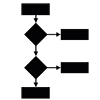
Accredited testing laboratory according to DIN EN ISO/IEC 17025:2018

Tabbed contents
Accredited testing laboratory
The Fraunhofer Institute for Manufacturing Engineering and Automation IPA in Stuttgart operates a testing laboratory whose competence has been confirmed by the Deutsche Akkreditierungsstelle GmbH (DAkkS). The scope of accreditation according to DIN EN ISO/IEC 17025:2018 covers the following fields:
Material testing:
Tests on paint raw materials, coating materials, coatings and coated surfaces
- Corrosion and climatic tests
- Mechanical testing of coated surfaces
- Tests for paint wetting impairment substances
- Optical tests
- Coating thickness measurements
- Media resistance tests
- Determination of fogging behavior
- Determination of burning behavior
- Determination of the odor behavior
- Selected analytical testing methods
Cleanliness testing technology
- Technical Cleanliness
- Determination of air purity based on particle concentration
Biological testing: In vitro test systems
- Cytotoxicity tests
- Irritation and corrosion tests on reconstructed human tissue models (Admission to the accredited area with the new certificate coming soon.)
Medical device testing:
- Biological testing: In vitro cytotoxicity tests
- Physical testing: Testing of particulate impurities (Light microscopy)
Where formally possible, the Fraunhofer IPA test laboratory practices the flexible category B scope. This empowers the testing laboratory to include further standardized test procedures in the above-mentioned accredited test areas in a prompt, flexible and unbureaucratic manner.
At the same time, the testing laboratory attaches the utmost importance to the reliability of its test and measurement procedures as well as to meeting the expectations and requirements of its customers.
The tests are performed in different laboratories belonging to the institute; these are operated by the following working groups:
In the Department of Coating Systems and Painting Technology:
- Analytics and Material Testing
- Applied Coating Technology
- Painting Process Engineering
- Wet Application and Simulation Technology
In the Department of Ultraclean Technology and Micromanufacturing:
Your advantages thanks to our quality management system
For many years, Fraunhofer IPA has been successfully operating an ever-growing quality management system according to DIN EN ISO/IEC 17025.
DIN EN ISO/IEC 17025 was developed with the aim of improving people’s confidence in the work performed by laboratories. By rigorously implementing DIN EN ISO/IEC 17025 requirements, we achieve valid and reproducible results and demonstrate our expertise in the areas accredited by Deutsche Akkreditierungsstelle GmbH. (Registration number of the accreditation certificate: D-PL-11140-07-00)
The main DIN EN ISO/IEC 17025:2018 requirements applicable to our quality management system are summarized below:

Confidentiality and impartiality
- We carry out all activities for you impartially.
- Everything we do is treated confidentially.

Clear definitions within the quality management system
- All testing activities that we perform for you, including the test equipment used, the authorized members of staff concerned, and the premises, are clearly defined.
- The organization, structure, responsibilities and authority of our accredited department within Fraunhofer IPA are precisely described.
- We are constantly improving our quality management system for you.

Work geared to customer needs
- Any products or services obtained externally are verified and approved by us.
- All requests, quotations and contracts are reviewed following established processes. Of course, we will inform you if we consider your proposed procedure to be outdated or inappropriate, as well as of any contractual discrepancies.
- If you submit a complaint to us, it will be handled according to a standardized process that we arrange with you.

Accredited test procedures, measurement uncertainty, traceability and verification
- Subject to the flexibilization according to category B, we can now add further standardized test procedures - in line with your request - to our already accredited test areas in a prompt, flexible and unbureaucratic manner.
- Where possible, all measurement and test results that you receive from us are metrologically traceable.
- We also calculate the margin of measurement uncertainty for our test and measurement results for you if this is feasible. If you wish, this can be taken into account in a statement of conformity.
- All tests with a valid version of a normative basis are verified to make certain that the required standard of performance is achieved.

Monitored test procedures and staff competence
- Regular internal audits and external assessments (e.g. by DAkkS) ensure that the requirements of DIN EN ISO/IEC 17025 are implemented in our quality management system and when we carry out our test procedures.
- The competencies and qualifications of our personnel are specified in all areas and are regularly monitored.

Validity of your results
- We undertake a variety of measures to ensure the validity of your results. Depending on the procedure, these include the use of reference materials with control cards, the execution of round robin tests and proficiency tests with other accredited laboratories, and comparisons in our own laboratory.

Risk and opportunity analyses
- We conduct regular opportunity/risk analyses in various areas of our quality management system in order to continuously improve our services for you.
Tests on coated surfaces
Range of services in accredited area - Material tests on paint raw materials, coating materials, coatings and coated surfaces
Range of services in flexibly accredited area category B
Corrosion and climatic tests
- Corrosion resistance
- Resistance to humidity
- Resistance to artificial weathering (xenon-arc lamp)
Description |
According to |
Status |
organisation unit |
Textiles - Tests for colour fastness - Part B06: Colour fastness and ageing to artificial light at high temperatures: Xenon arc fading lamp test |
DIN EN ISO 105-B06 |
2020-12 |
|
Paints and varnishes - Determination of resistance to humidity - Part 1: Condensation (single-sided exposure) |
DIN EN ISO 6270-1 |
2018-04 |
|
Paints and varnishes - Determination of resistance to humidity - Part 2: Condensation (in-cabinet exposure with heated water reservoir) |
DIN EN ISO 6270-2 |
2018-04 |
Applied Coating Technology (Coated metal substrates) |
Painting Process Engineering (Coated plastic substrates) |
|||
Corrosion tests in artificial atmospheres - salt spray tests (Neutral salt spray test, NSS test; Copper-accelerated acetic acid salt spray test, CASS test) |
DIN EN ISO 9227 |
2023-03 |
|
Paints and varnishes - Determination of resistance to cyclic corrosion conditions - Part 1: Wet (salt fog)/dry/humid, cycle B |
DIN EN ISO 11997-1 |
2018-01 |
|
Paints and varnishes - Methods of exposure to laboratory light sources - Part 2: Xenon-arc lamps, method A |
DIN EN ISO 16474-2 |
2022-11 |
Coating thickness measurements
- magnetic method
- amplitude-sensitive eddy current method
- cross-grind-/crosscut-method
Description |
According to |
Status |
organisation unit |
Non-magnetic coatings on magnetic substrates - Measurement of coating thickness - Magnetic method |
DIN EN ISO 2178 |
2016-11 |
|
Non-conductive coatings on non-magnetic electrically conductive base metals - Measurement of coating thickness - Amplitude-sensitive eddy-current method |
DIN EN ISO 2360 |
2017-12 |
|
Paints and varnishes - Determination of film thickness (section 5.4.4 method 6A - Cross-grind/Cross-cut method) |
DIN EN ISO 2808 |
2019-12 |
Mechanical testing of coated surfaces
- Abrasion resistance to rubbing by fingers and hands
- Scratch resistance and abrasion resistance (spring-loaded pen, laboratoryscale car-wash, crockmeter)
- Determination of adhesive strength – cross-cut test, multi-impact testing, pressure water jet
Description |
According to |
Status |
organisation unit |
Environmental testing - Part 2: Tests - Test Xb: Abrasion of markings and letterings caused by rubbing of fingers and hands |
DIN EN 60068-2-70 |
1996-07 |
|
Paints and varnishes - Cross-cut test |
DIN EN ISO 2409 |
2020-12 |
Applied Coating Technology (Coated metal substrates) |
Painting Process Engineering (Coated plastic substrates) |
|||
Paints and varnishes - Determination of the resistance of coatings to pressure water-jetting |
DIN EN ISO 16925 |
2022-06 |
|
Paints and varnishes - Determination of stone-chip resistance of coatings - Part 1: Multi-impact testing |
DIN EN ISO 20567-1 |
2017-07 |
|
Paints and varnishes - Scratch test using a spring-loaded pen |
DIN EN ISO 22557 |
2021-02 |
|
Textiles - Tests for colour fastness - Part X12: Colour fastness to rubbing |
DIN EN ISO 105-X12 |
2016-11 |
|
Paints and varnishes - Determination of the scratch resistance of a coating system using a laboratory-scale car-wash |
DIN EN ISO 20566 |
2021-06 |
|
Paints and varnishes - Determination of the resistance to rubbing using a linear abrasion tester (crockmeter) |
DIN EN ISO 21546 |
2021-02 |
Optical tests
- Determination of color and color differences
- Visual evaluation of degradation of coatings
- Visual comparison of color
- Determination of gloss value
Description |
According to |
Status |
Organisation unit |
Colouring materials - Conditions of measurement and evaluation for the determination of colour differences for paint coatings, similar coatings and plastics, method B |
DIN 53236 |
2018-02 |
|
Paints and varnishes - Determination of gloss value at 20°, 60° and 85° |
DIN EN ISO 2813 |
2015-02 |
|
Paints and varnishes - Visual comparison of colour of paints |
DIN EN ISO 3668 |
2020-05 |
|
Paints and varnishes - Evaluation of degradation of coatings - Designation of quantity and size of defects, and of intensity of uniform changes in appearance - Part 1: General introduction and designation system |
DIN EN ISO 4628-1 |
2016-07 |
|
Paints and varnishes - Evaluation of degradation of coatings - Designation of quantity and size of defects, and of intensity of uniform changes in appearance - Part 2: Assessment of degree of blistering |
DIN EN ISO 4628-2 |
2016-07 |
Tests for paint wetting impairment substances
Description |
According to |
Status |
organisation unit |
Testing for paint wetting impairment substances (LABS-conformity) |
VDMA Specification 24364 |
2018-05 |
Media resistance tests
Description |
According to |
Status |
Organisation unit |
Paints and varnishes - Determination of resistance to liquids - Part 3: Method using an absorbent medium |
DIN EN ISO 2812-3 |
2019-08 |
|
Paints and varnishes - Determination of resistance to liquids - Part 4: Spotting methods |
DIN EN ISO 2812-4 |
2018-03 |
Determination of fogging behavior
Description |
According to |
Status |
organisation unit |
Determination of the fogging characteristics of trim materials in the interior of automobiles |
DIN 75201 |
2023-11 |
Determination of burning behavior
Description |
According to |
Status |
organisation unit |
Determination of burning behaviour of interior materials in motor vehicles |
DIN 75200 |
1980-09 |
Determination of the odor behavior
Description |
According to |
Status |
organisation unit |
Determination of the odour characteristics of trim materials in motor vehicles |
VDA 270 |
2018-06 |
Range of services in the accredited area without flexible accreditation
Selected analytical tests
Description |
According to |
Status |
Organisation unit |
Identification of binder type by infrared (IR) spectroscopy |
SAA AS 01.0 Standard operation procedure of Fraunhofer IPA |
2020-10 |
|
Determination of glass transition temperature and melting point by Differential Scanning Calorimetry (DSC) |
SAA AS 03.0 Standard operation procedure of Fraunhofer IPA
|
2019-12 |
medical device testing
Range of services in accredited area - medical device testing
Range of services in the accredited area without flexible accreditation
Tests for in vitro cytotoxicity
Description |
According to |
Status |
organisation unit |
| Biological evaluation of medical devices - Part 5: Tests for in vitro cytotoxicity | DIN EN ISO 10993-5 | 2009-10 | Cleanliness Technology |
Cleanliness tests
Description |
According to |
Status |
organisation unit |
| Cleanroom technology - Cleanliness of medical devices in the manufacturing process, B3.3 Particulate impurities, Light Microscopy (automated with image processing) | VDI 2083, Part 21 | 2019-10 | Cleanliness Technology |
Biological tests
Range of services in accredited area - Biological testing: In vitro test systems
Range of services in flexibly accredited area category B
Cytotoxicity tests
Description |
According to |
Status |
organisation unit |
Biological evaluation of medical devices - Part 5: Tests for in vitro cytotoxicity (here without conformity assessment for medical devices) |
DIN EN ISO 10993-5 |
2009-10 |
Cleanliness testing technology
Range of services in accredited area - Cleanliness testing technology
Range of services in flexibly accredited area category B
Technical Cleanliness
Description |
According to |
Status |
organisation unit |
Inspection of Technical Cleanliness - Particulate contamination of functionally-relevant automotive components Chapter 5 Qualification tests and blank value Chapter 6 Extraction method Chapter 7 Analysis filtration Chapter 8.2.2 Light-optical analysis Chapter 8.3.2 SEM/EDX |
VDA volume 19 part 1 (VDA Verband der Automobilindustrie) |
2015-03 |
|
Road vehicles - Cleanliness of components and systems Chapter 6 Qualification tests and blank level Chapter 7 Extraction methods Chapter 8 Analysis filtration Chapter 9.2.3 Light-optical analysis Chapter 9.3.2 SEM/EDX |
ISO 16232 |
2018-12 |
|
Technical Cleanliness in assembly - Enviroment, Logistics, Personnel and Assembly Equipment Chapter G.2 Particle traps Chapter G.3 Stamp tests Chapter G.4 Cleanliness of liquids |
VDA volume 19 part 2 (VDA Verband der Automobilindustrie) |
2010-09 |
|
Space product assurance - Particles contamination monitoring for spacecraft systems and cleanrooms Chapter 5.1.1 Tape lift method (here stamp test) Chapter 5.1.2 Direct deposition on silicon wafers Chapter 5.1.3 Rinsing (direct or indirect) Chapter 5.2.1 Particles sampling from filtered liquid samples Chapter 5.3 Particles counting with microscope |
ECSS-Q-ST-70-50C (ECSS European Cooperation for space standardization) |
2011-10 |
Determination of air purity based on particle concentration
Description |
According to |
Status |
organisation unit |
Classification of air purity based on particle concentration |
DIN EN ISO 14644-1 |
2016-06 |